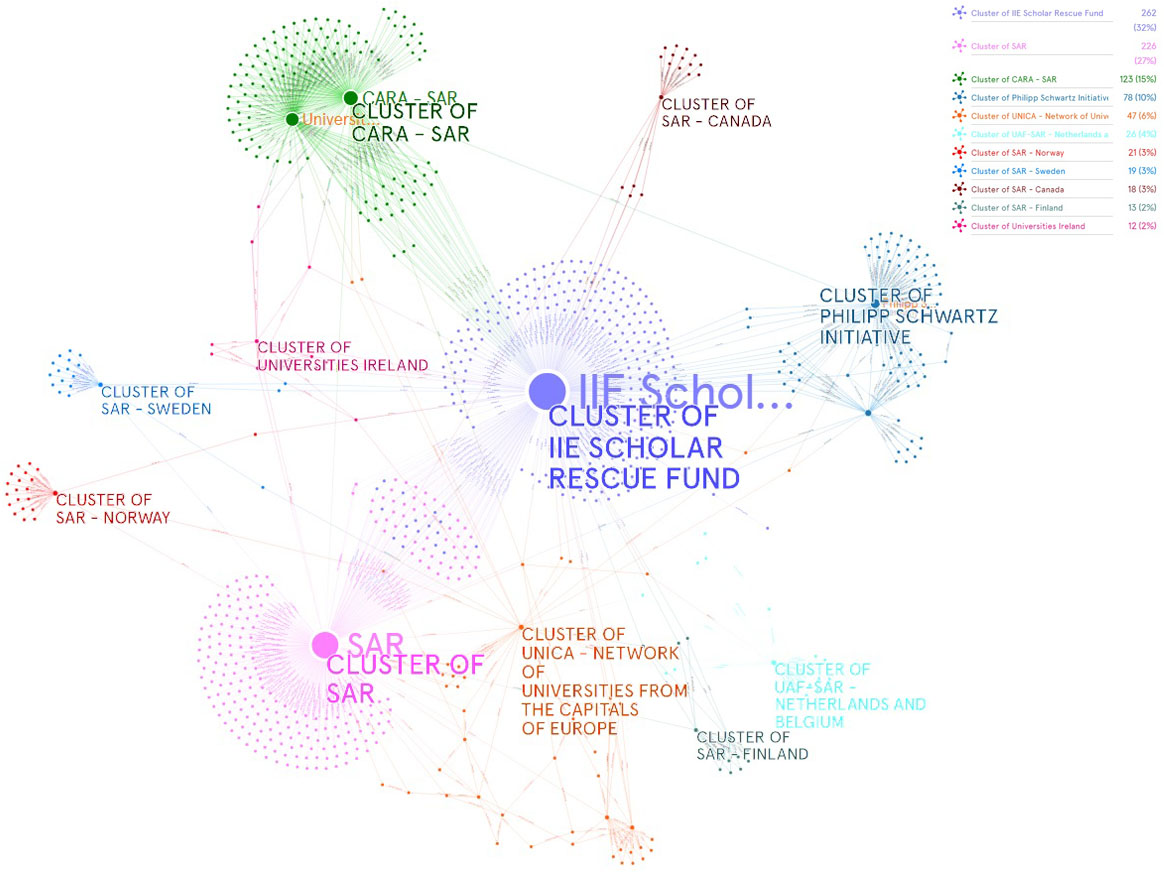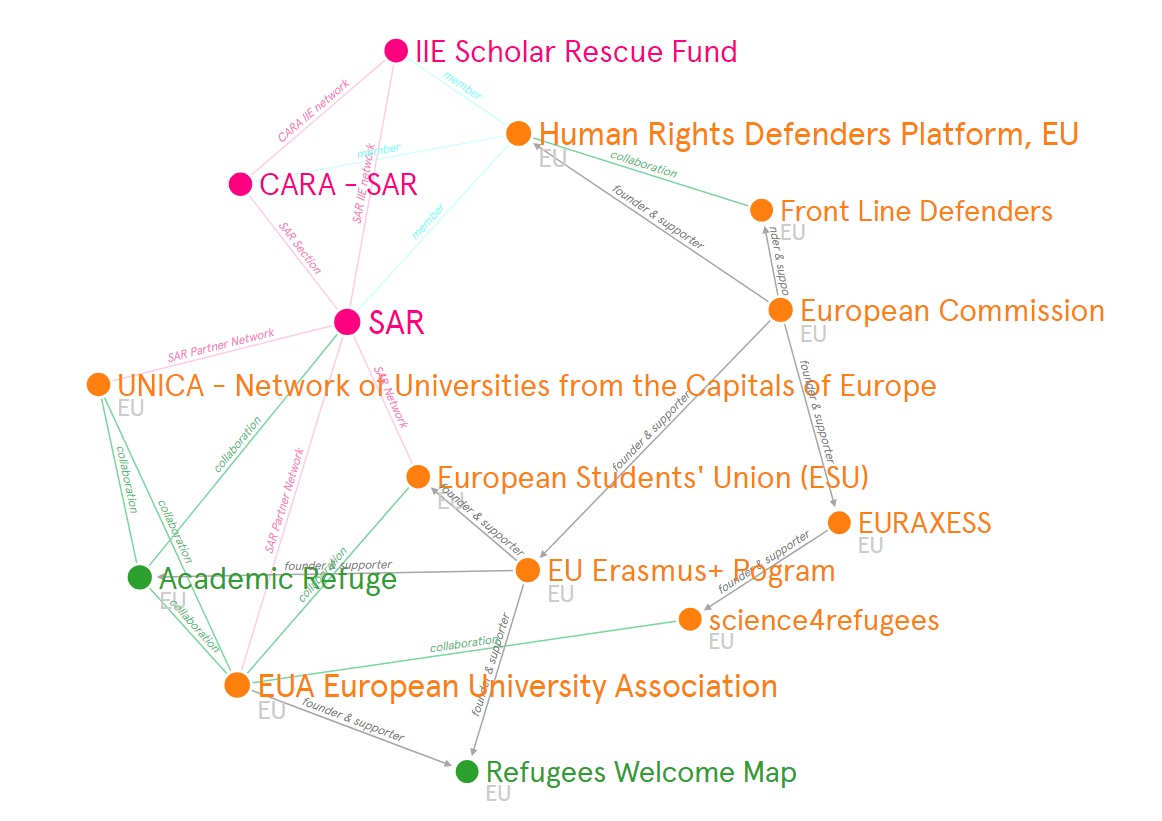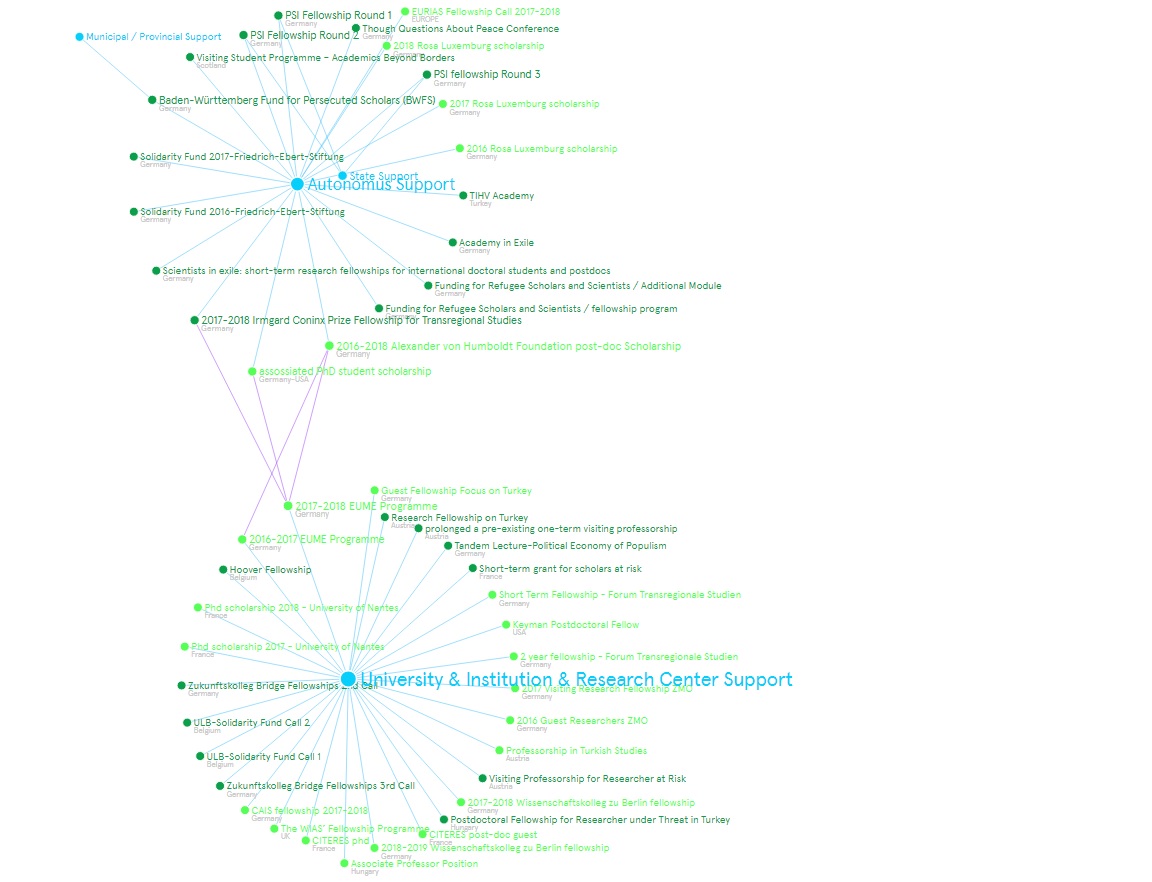MAPPING FUNDS AND SUPPORT NETWORKS FOR AT-RISK SCHOLARS: CASE OF TURKEY[1]
Executive Summary
We are passing through times of authoritarian purge and crackdowns with their tremendous pressure on academic freedom and mobility. Since 2015, first with the migration crises because of the war in the Middle East, then the fake coup attempt in Turkey and discriminatory domestic politics, finally with the aggregation of right populisms all over the world, this issue is blazed out in Europe again.
All over the world, many endangered scholars have been imprisoned and lost their jobs, have either had to flee or are still working in their home countries despite many risks. The year of 2016 was marked by the emblematic impact of many organizations, foundations, federal and state bodies, universities and institutions in Europe declaring their support to endangered academics; some of them have been working on urgent help for academics at risk for many years, some of them have just started; while others felt immediate responsibility and took concrete steps, a few others have been offering their support in indirect ways.
We must underline the fact that support schemes and funds provided to at-Risk Scholars are really diversified. This diversification has its pluses as well as minuses. The aim of this project is to analyze this diversified network for the purpose of generating a route map for scholars, students and the wide public; thus to discuss the institutional roles for advancing common knowledge production.
Research & Methodology
The main focus of our project is analyzing the network of funds and assistance received by at-Risk Scholars from Turkey since 2016. The research team in this project strictly abides by ethics of collegiality and personal privacy as well as confidentiality measures of assisting organizations. Accessing the recipient`s information is not possible without institutional collaboration. Confidentiality is also essential for this project to protect scholars and foundations. Thereby, the aim of the project is to achieve collaborative network mapping process for enriching the community of scientific knowledge production.
Under these conditions, we have prepared two different maps, one of them public, the other one private. The public map “Support Networks of Scholars at Risk” illustrates the already declared supporter network which is publicly accessible and open to contribution. The private map “Funds for Endangered Researchers from Turkey” shows the funds and their institutional supporter network which is only visible for selective collaborators because of confidentiality and personal privacy issues. Also this second map is a work-in progress and needs to develop with the collaboration of supporter institutions.
The idea of the network map is to conceive the relationality between the actors and to recognize the leader actors, understand the central role, as well as intermediary pathways, bridges and peripheries. This method of visualization facilitates the investigation of key points in the subject matter and the actual research question.
The first step of the project was collecting the data from web sites and personal connections. The first map which is public contains only public data from web sites. The second map which is private includes both public data and personal contact info.
After data collection, to visualize them, “Graphcommons” (www.graphcommons.com) online platform was used. This platform was chosen because its working interface is more familiar among scholars and students in Turkey. This is important for the project, considering the map progress through interactive public contribution (crowdsourcing) during the next stage.
During the first stage of the project we have created the map through data collection and as part of second phase we have done emailing to several institutions to ask for collaboration during the mapping process. During the first stage, we could reach 38 different support mechanisms; after implementing the communication with institutions through e-mail, we could access in total 69 support mechanisms and the private map has been improved. The next step of project is envisioned as further collaboration with diverse actors to be able to pitch a generator-friendly web site open to interactive contributions at the Brussels workshop in June 20, 2018.
During the visualization, the idea was to understand the main actors and relations without going into further complications. However, the details were also embedded to the map as properties, a platform tool for filtering and deeper investigation.
Last part of the project covers in-depth analysis of the maps.
Next are some map illustrations to give the readers an idea about the work in practice as well as the public data to be analyzed.
Map Illustrations
Cluster of Support Networks of Scholars at Risk in/from Turkey

http://mappingfunds.com/en-US/Maps/List
The leading institutions have been indicated as SAR, CARA and IIE and Phillip Schwartz Initiative with its edge and bridge role. IIE acts as the agency figure with its country representation across and beyond Europe. The central role from the network belongs to connecter actors between the clusters. Connector actors have bridges role between clusters and leader actors to strengthen the ties.
European Union Network

http://mappingfunds.com/en-US/Maps/List
SAR has the central role with its degree centrality in this visual; however the EUA also serves the network diversity with its in betweenness centrality. Edge actors, CARA, IIE, Erasmus Program and EURAXESS are connectors and have the potential of expanding the network towards more diverse networks and initiatives.
Distribution of Support to Scholars From and/or in Turkey

Philipp Schwartz Fellowship funded by Alexander Von Humboldt Foundation creates the largest part of the support from Germany. PAUSE (Programme d’Aide à l’accueil en Urgence des Scientifiques en Exil) provides the largest part of the support from France. However, the actual number of beneficiaries from PAUSE could not be accessed! Visiting Student Programme – Academics Beyond Borders from Scotland and TIHV-Academy funded by Human Rights Foundation of Turkey are main shapers of the considerably high scores in Turkey and Scotland.
Direct & indirect supports received by scholars from or in Turkey

http://mappingfunds.com/en-US/Maps/List
This map includes all direct (Funds, fellowships, scholarships) and Indirect support (Project, publication, translation and inter-institutional assistance) provided by series of calls of all institution/initiative types mapped within the interstices of the project.
Preliminary Findings
•69 different support/fellowship/position items have been mapped, out of which %58 of is direct support.
•Universities and research institutions have provided the most substantial support among all diverse actors so far with %51 in all direct/indirect funds. Autonomous Support follows with %29, Municipal / Provincial support %2 and state support %1. Some of the support is funded by two or more institutional types (such as PAUSE) and the ratio of that relational support is %17 including Universities and research institutions, Autonomous Support and state support.
•Communication and relation between actors based on support schemes mainly exist within the countries. Only a few actors play the bridge role between countries generally as a partner and not as financial supporter. Only one umbrella organization, IIE having a bridge role between France, Germany and Belgium clusters with respect to the existing funds. Philipp Schwarz Initiative between France and Germany, Institut d'Etudes Avancées de Nantes between France and Europe, University Edinburgh between Scotland and Europe, Wissenschaftskolleg zu Berlin between Germany and Europe sustain relation and communication.
•On European states correlation basis, Germany grabs attention as the most substantial support & assistance provider, followed by France, Belgium and Austria.
•23% of all beneficiaries are from Turkey, 4% of them live in Turkey and 1% of them could not receive the awarded support because of mobility restrictions in Turkey.
•The mainstream, type of position received by scholars from Turkey but living outside of Turkey is fellowship, it is 84% of all supports, followed by scholarships at the rate of 10%, guest professorship and remote conference at the rate of 3% and 1% tandem (one professor in Germany, the other in Turkey acting as remote co-lecturers) lectures. The most sustained programs of fellowship are PSI from Germany and PAUSE from France.
•The newly emerging and innovative type of position achieved by scholars living in Turkey is remote visiting student program with 51% of all, followed by remote conference and project researcher at the rate of 23%, and 1% tandem (one remote) lecture. Remote visiting student program Beyond Borders of Scotland and Off University of Germany have created exceptional remote offers for Scholars at Risk living in Turkey. Also Human Rights Foundation of Turkey provides funds for research projects inside Turkey.
•51% of the support is provided for Post-doc Researchers (including young or senior) and 13% of them for PhD/master students. 33% of the support is provided for both Phd students and post-doc researchers but distribution of these funds is not identified. PAUSE is the most prominent initiative for PhD/master scholarship. Once again remote visiting student program, Beyond Borders of Scotland also provides assistance for PhD students.
Conclusive Remarks
Actor network mapping is an efficient tool for understanding the working scheme of specific communities and it creates possible pathways towards a guidance document for improving ties between actors and for knowledge sharing. Data collecting, analyzing and mapping effort of funds for Scholars at Risk aims to be a talking document between actors to create sustained financial support for academic knowledge production at tough times.
Two different maps indicate differences between partner connections and corporations for providing support. First map illustrates partner connections coordinated by umbrella organizations of SAR, CARA and IIE, respectively by 734 universities & institutions, 76 foundations & initiatives, 16 public utilities and 2 companies. However, regarding the existing support items, umbrella organizations do not have efficiency. Also the number of the supporter actors of university & institution and foundation & initiative dramatically decrease to 188 and to 40; number of the public institutions increase to 23. Although the central role of umbrella organizations are substantial for sharing knowledge, second map shows the lack of relations between actors by country and by different type of supports.
On the other hand this mapping project itself aims to carry out collaborative relations with actors from the network. To achieve this objective during the second phase of the project we have contacted the supporter institutions via e-mail. Related map has progressed according to responses. The collaborative mapping workshop organized on June 20, 2018 will facilitate more interactions. Project website will be beta-tested for common contributions and to expand the network.
Suggestions for Improvement and Further Exchange
•It is clear that MA/PhD students have the most vulnerable conditions in Turkey since their early academic career is at an unprecedented halt; they can not earn bread through research or part-time teaching due to dismissals and black-labelling or continue writing their dissertations. As for PhD-holder at-Risk Scholars with families and economic hardship, conditions are also severe since the purge. These clusters need special assistance due to passport confiscations and mobility restrictions. Best assistance cases so far have been: Online mentoring, free use of online library resources, home-based project/translation tasks paid in lump-sum and online adjunct lectureships.
•Mobility restrictions affect all scholars living in Turkey. Most of them could not receive the support even if they were awarded due to passport confiscations. Thus online remote lectureship facilitates both teaching and researching and must be encouraged. So far such efforts do not have a central role with limited connections on the map, but weaving such relations holds promises both for at-Risk Scholars and for academic knowledge production beyond borders with the aid of technology.
•Relations, communications and cooperation between countries based on given funds should be increased and best practices must be showcased for mutual learning and knowledge sharing beyond borders.
•Collaboration with this mapping effort through institutionally endorsed data, such as distribution by gender and field of research would help identify gaps that pose as blockages against common voices towards peace studies.
•Crowdsourced data is what we are aiming for since interactive fora and exchange by diverse actors is the genuine means for critical knowledge production. Thus, interactive means of exchange must be encouraged by all actors in the network as well as those interested to be welcomed.
[1] Project Supervisor: Assoc.Prof. Asli Telli Aydemir; Researchers: Hazal Gümüs and Dilek Karabulut
